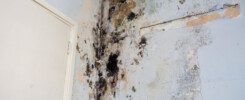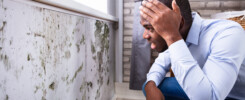Does your home have exposure to mold? Around 21% of asthma cases are attributable to household mold and dampness. Mold also accounts for a substantial 93% of chronic sinus infections.
Black mold refers to a particularly toxic mold variety associated with many physical and mental health issues. What exactly is black mold, and why is removing black mold important to your health? Keep reading to learn these answers and more!
What Is Black Mold?
Mold and mildew are very widespread. You’ve probably already encountered it growing on food left out too long, or in bathroom tiles and grout. Houses in certain climates will even grow mold on their roof.
Most mold and mildew strains are benign, although they’re unsightly and can cause wood rot. Widespread mold infestations can also cause health hazards. Many commercial household cleaners are specifically made to eliminate common household molds and bacteria.
Black mold generally refers to the Stachybotrys chartarum variety, although many mold strains can be black or dark in color. Stachybotrys chartarum can contain potent mycotoxins.
Mycotoxins are most commonly found in contaminated commercial food and drink products. They’ve been linked to many severe health problems, including organ damage and cancers.
Many symptoms of chronic mycotoxin poisoning, or mycotoxicosis (from organic product exposure) are similar to the reported health effects of black mold in homes.
Who Is at Risk for Mold Poisoning?
Black mold infestation can cause issues for anyone, but people with certain health conditions are especially vulnerable. According to the Center for Disease Control (CDC), these include:
- Asthma
- Allergies
- Chronic respiratory illnesses
- Immune system issues
- Organ transplants
- Certain cancers like leukemia
- Lung issues
Exposure to mold can also be particularly harmful to children and senior adults. The World Health Organization (WHO) confirmed a direct link between childhood asthma development and mold exposure in 2018.
Mold has also been linked to the development and heightened symptoms of allergies. The most common allergies include animal dander, dust mites, and mold, all of which are habitually found in homes.
Symptoms of Black Mold Exposure
Black mold exposure has many different symptoms, ranging from mildly irritating to debilitating. The effects of toxic mold also mimic many other health conditions, so it can be difficult to track down black mold as the root cause.
Physical symptoms can include chronic:
- Fevers
- Coughing
- Sneezing
- Nosebleeds
- Congestion
- Itchy and/or watery eyes
- Headaches
- Body aches
- Muscle weakness
- Rashes
- Dry skin
- Recurring respiratory illnesses (flu, colds)
- Sinus infections
Black mold exposure can also cause mental health symptoms. These can include:
- Fatigue
- Anxiety
- Depression
- Irritability
- “Brain fog”
- Memory loss
- Insomnia
Household mold ingestion is rare, and usually involves benign mold types growing on food before people notice it. If mold containing mycotoxins is ingested, however, symptoms can include vomiting and diarrhea.
Signs of Black Mold Around Your Home
Black mold can be very obvious, or it can sneak into places you can’t see. Along with its tell-tale dark color, black mold signs include:
- Musty smells
- Water damage circles
- Peeling or bubbling paint
- Warped drywall
- Soft floor spots
If mold starts invading hard-to-see areas like insulation and HVAC systems, your health-related symptoms and the strong musty earth smell of black mold may be the clue you have for mold exposure.
If you experience any symptoms and/or notice signs of black mold, it may be time to test your air for mold exposure. Once you’ve confirmed black mold is the culprit, there are strategies you can take to remove it.
Removing Black Mold
You may keep your house squeaky clean, and not see visible mold or mildew anywhere. Mold is present in over 70% of homes, however. While it can grow anywhere there’s persistent moisture, mold especially loves damp and dark places.
You can remove most small, common, and visible mold growth using natural or chemical methods. However, it’s highly recommended to use professional services for black mold remediation.
Not only is black mold very difficult to remove in some places, but casually cleaning it off can actually make it spread even further. Mold releases even more spores when it’s disturbed. This increases your toxic mold exposure and allows black mold to reach other areas undetected.
Mold Removal Prep
Cleaning mold isn’t as casual as your everyday washing or disinfecting rituals. Even if you use gentle, all-natural cleaning solutions, you’ll still need to guard yourself against mold contact. These include:
- Rubber gloves
- Breathing mask
- Eye protection
- Protective clothing coverings
You should throw away disposable safety coverings as soon as you’re done. It’s also important to throw away any towels, brushes, or rags used to wipe up the mold. If these aren’t sealed off and disposed of, they could spread mold spores around your house.
Natural Mold Removal
If you want to avoid harsh chemicals, some molds can be removed using natural substances. There are many mold-cleaning solution recipes online, whose main ingredients include:
- Hydrogen peroxide
- Vinegar
- Baking soda
- Tea tree oil
- Grapefruit seed extract
- Salt (for scrubbing)
- Citrus extract/juice (odor removal)
Since you may have to scrub, the natural mold removal method works best on small recurring areas that are easily accessible and have hard surfaces. This includes:
- Garbage disposals
- Sinks
- Toilets
- Refrigerators
- Bathroom tiles
- Dishwashers
- Washing machines (avoiding rubber parts)
- Vinyl floors (diluted)
Vinegar and hydrogen peroxide bases can be harsh on other surfaces and may cause abrasion or discoloration. It’s highly recommended to test a small area of the surface before cleaning it with these solutions.
It’s generally not recommended to use these solutions for carpets, walls, grout, and hardwood floors. Vinegar should also be avoided on granite or marble countertops and rubber parts.
Many all-natural cleaning brands also make mold removal products, which may be more versatile than vinegar and hydrogen peroxide. The label should tell you what surfaces these products are safe to use on.
Chemical Mold Removal
If you have large, stubborn, or hard-to-reach areas of mold and you don’t want to use all-natural methods, there are common household chemical agents that can also work. These include:
- Bleach
- Ammonia
- Borax
- Certain detergents
- Rubbing alcohol
These chemicals may also be effective at removing lingering mold stains. They can also have toxic effects of their own, so it’s important to use them safely.
Bleach and ammonia should never be mixed together, for example, because this creates toxic fumes. All of these chemicals are also harmful if ingested, inhaled, or come into too much contact with your skin.
Like vinegar and hydrogen peroxide, these chemicals are only compatible with certain surfaces. Depending on the chemical agent, surfaces to avoid can include:
- Granite/marble countertops
- Wood furniture
- Metal
- Carpets and fabrics (undiluted)
- Hardwood floors
- No wax floors
- Painted surfaces
- Acrylics
Care should also be taken to keep these agents away from food or other ingestible products. Ammonia and rubbing alcohol are also flammable, so they should be kept away from potentially hot surfaces like stoves and ovens.
You can also buy commercial cleaning products made specifically for certain surfaces, like bathroom fixtures or wood. These products are formulated to kill mold without damaging the surface underneath.
Black Mold Remediation
Mold removal refers to superficially cleaning off the visible mold. Regular mold removal is common for bath and kitchen areas.
What happens if your mold is in areas that are difficult to reach or clean with ordinary cleaning methods? How do you get rid of stubborn recurring mold for good? What if you suspect black mold is causing adverse health conditions?
In these cases, your best course of action is to call for professional mold remediation. Remediation refers to the total elimination of a problem.
There are many benefits to these services, including:
- Advanced mold detection
- Limited exposure for you and your household
- Thorough mold removal
- Increased safety measures
- Decreased risk for re-infestation
Professional mold remediation teams have all the expertise and experience needed for removing black mold. They also have all the safety equipment on hand to remove all toxic mold while preventing its spread to other areas of your house.
Mold remediation is a straightforward process:
- Mold assessment and testing
- Source identification
- Water and dampness removal
- Area seal-off
- Mold surface removal
- Mold air removal
- Disposal of non-cleanable items
- Deep disinfecting
- Deodorizing
You can thoroughly scrub and clean mold off most surfaces, but it’s difficult to remove mold from below a surface. Mold will also reoccur if the source of moisture isn’t addressed. For these reasons and more, mold remediation is usually the best option.
Improve Your Health and Your Home With Black Mold Removal Today!
Mold is a persistent household pest. Black mold is a toxic variety that can adverse health conditions along with unsightly splotches and musty smells.
All-natural and chemical cleaners can help you remove common molds, but removing black mold can be difficult and risky to your home and health. It can even make mold infestations worse. Experts recommend mold remediation services to deal with severe and toxic mold problems.
Are you looking for top-notch mold remediation services? Our expert team has over 45 years of experience and is dedicated to providing the high-quality customer service you deserve. Contact us to get started!


